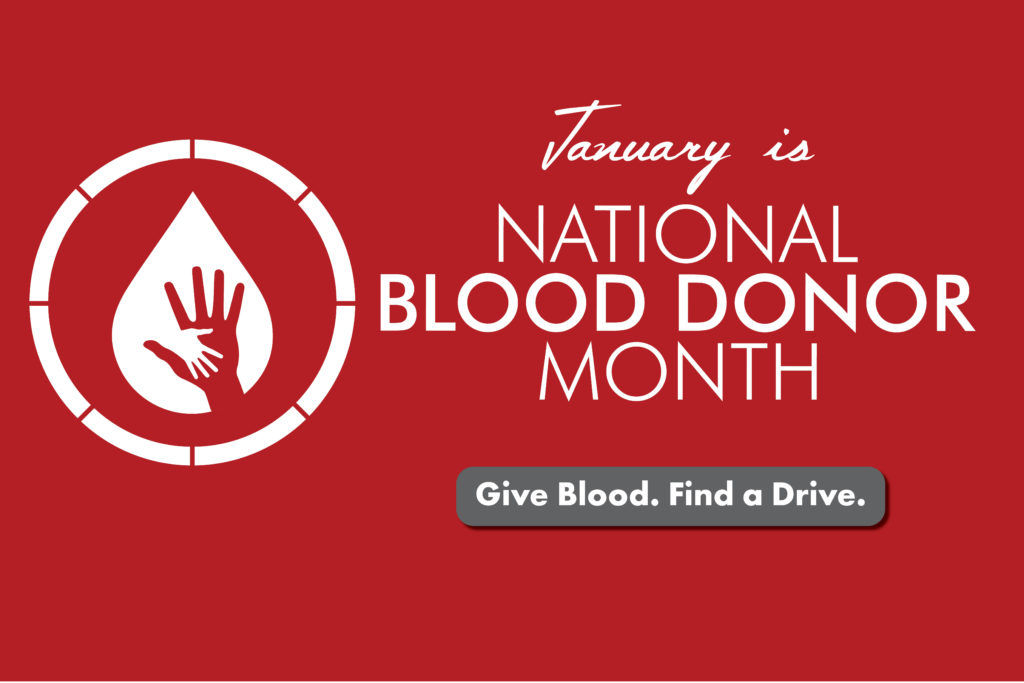The gift-giving season may seem like it’s over, but when it comes to giving the gift of life, the season never ends. A donation of blood can mean life or death to someone in need. When you make a blood donation, you may be helping a patient with cancer, helping someone recover from surgery, or even saving someone from death. According to the American Red Cross, every two seconds someone in the U.S. needs blood. In this country alone, approximately 29,000 units of red blood cells are needed daily and nearly 5,000 units of platelets and 6,500 units of plasma are needed daily. Nearly 16 million blood components are transfused each year. The average red blood cell transfusion is approximately three pints. A single-car accident victim can require as many as 100 pints of blood. January is Blood Donor Month. Can you help?
From signs on store windows to Facebook ads, you can’t go far without seeing a blood drive announcement. If you’ve never given blood, you may wonder what a blood drive even is! It can be intimidating to wonder what happens at this event and how exactly they get your blood, so here’s a brief rundown:
- Ideally, you register online for an appointment at a local blood drive.
- Upon arrival, you will be greeted by local volunteers who will ask you if you have an ID (you need an ID or a blood donor card to donate).
- You will be given some reading materials that everyone must read before they donate. It will tell you about the process, provide information on different medications, lifestyles, and different areas of travel that may keep you from donating, as well as other general blood donor info. You can save time on this by filling out RapidPass® online before your donation.
- Then, you sit back, have a free drink, and then you will wait until you are called for your turn.
Once your name is called, this is where the “action begins!”
- You will be greeted by a technician who will bring you to a secure area. In this area, you will give your name, date of birth, and other general information.
- The technician will also check your blood pressure, pulse, temperature, and blood iron levels. When they confirm that these are in the healthy zone for donating you will be asked a variety of questions that help ensure you are a proper candidate for donation.
Then it’s on to the actual donation. The collection process goes quickly.
- You will be brought over to your own comfy lounge, where they will reverify your information and cuff your arm just like the one used to read your blood pressure.
- They will cleanse the area and likely mark the vein to make sure they can have a smooth insertion. After a small pinch and maybe a slight burn, the needle will be in and really you shouldn’t feel much of anything.
- You may be asked to squeeze a soft ball every now and then and really it’s just minutes until your blood donation is complete. Once your collection bag is full, the needle will be removed, and they will place a small bandage over the area and send you over to another area to enjoy some snacks and beverages.
How simple is that? You answer a few questions, get a free iron test, unlimited drinks and snacks, and maybe even a free gift (The Red Cross often has different sponsors and giveaways) and you can potentially save up to 10 lives with one donation! Donating blood can seem scary, especially the first time, but really, it’s quick, simple, and other than a quick poke of a needle it’s almost pain-free. Your blood donation could help save the life of a new mom who hemorrhages during childbirth or perhaps helps a sick child with leukemia, or maybe your donation helps several people living with different blood disorders and illnesses.
Not everyone is a proper candidate for donating blood, but you may be. Visit https://redcrossblood.org to see if you would be a potential donor. Encourage friends and family to join you in these efforts. Tell others when upcoming blood drives are in the area. If you can’t donate but want to help, consider volunteering at local blood drives, helping with advertising, or even making a monetary donation. Donating blood saves lives. We never know when we might need it, but those who have received donations can tell you they are so grateful for the donors! If you are a healthy candidate, donate – you too can be a lifesaver!
Mary Hoadley
Director of The Wellness Center


